
James Watt was a Scottish inventor, mechanical engineer, and chemist who improved on Thomas Newcomen's 1712 Newcomen steam engine with his Watt steam engine in 1776, which was fundamental to the changes brought by the Industrial Revolution in both his native Great Britain and the rest of the world.
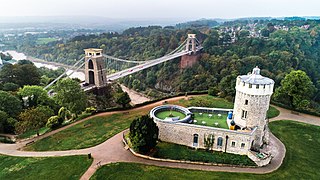
Bristol is a city, ceremonial county and unitary authority in England. Situated on the River Avon, it is bordered by the ceremonial counties of Gloucestershire, to the north; and Somerset, to the south. Bristol is the most populous city in South West England. The wider Bristol Built-up Area is the eleventh most populous urban area in the United Kingdom.

St Mary Redcliffe is an Anglican parish church located in the Redcliffe district of Bristol, England. The church is a short walk from Bristol Temple Meads station. The church building was constructed from the 12th to the 15th centuries, and it has been a place of Christian worship for over 900 years. The church is renowned for the beauty of its Gothic architecture and is classed as a Grade I listed building by Historic England. It was famously described by Queen Elizabeth I as "the fairest, goodliest, and most famous parish church in England."

Bristol Cathedral, formally the Cathedral Church of the Holy and Undivided Trinity, is the Church of England cathedral in the city of Bristol, England. Founded in 1140 and consecrated in 1148, it was originally St Augustine's Abbey but after the Dissolution of the Monasteries it became in 1542 the seat of the newly created Bishop of Bristol and the cathedral of the new Diocese of Bristol. It is a Grade I listed building.
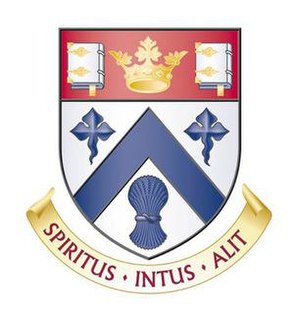
Clifton College is a public school in the city of Bristol in South West England, founded in 1862. In its early years it was notable for emphasising science rather than classics in the curriculum, and for being less concerned with social elitism, e.g. by admitting day-boys on equal terms and providing a dedicated boarding house for Jewish boys, called Polack's House. Having linked its General Studies classes with Badminton School, it admitted girls to the Sixth Form in 1987 and is now fully coeducational. Polack's House closed in 2005 but a scholarship fund open to Jewish candidates still exists. Clifton is one of the original 26 English public schools as defined by the Public Schools Yearbook of 1889.

Bristol Harbour is the harbour in the city of Bristol, England. The harbour covers an area of 70 acres. It is the former natural tidal river Avon through the city but was made into its current form in 1809 when the tide was prevented from going out permanently. A tidal by-pass was dug for 2 miles through the fields of Bedminster for the river, known as the "River Avon New Cut", "New Cut", or simply "The Cut". It is often called the Floating Harbour as the water level remains constant and it is not affected by the state of the tide on the river in the Avon Gorge, The New Cut or the natural river southeast of Temple Meads to its source.

A shot tower is a tower designed for the production of small-diameter shot balls by free fall of molten lead, which is then caught in a water basin. The shot is primarily used for projectiles in shotguns, and also for ballast, radiation shielding, and other applications in which small lead balls are useful.

Shot is a collective term for small balls or pellets, often made of lead. These were the original projectiles for shotguns and are still fired primarily from shotguns and less commonly from riot guns and grenade launchers, although shot shells are available in many pistol calibers in a configuration called "birdshot", "rat-shot", or "snake shot". Lead shot is also used for a variety of other purposes such as filling cavities with dense material for weight/balance. Some versions may be plated with other metals. Lead shot was originally made by pouring molten lead through screens into water, forming what was known as "swan shot", and, later, more economically mass-produced at higher quality using a shot tower. The Bliemeister method has supplanted the shot tower method since the early 1960s.
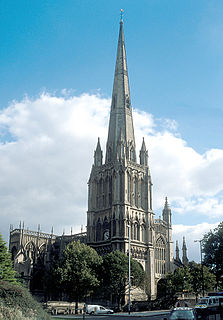
Bristol, the largest city in South West England, has an eclectic combination of architectural styles, ranging from the medieval to 20th century brutalism and beyond. During the mid-19th century, Bristol Byzantine, an architectural style unique to the city, was developed, and several examples have survived.

St Mary Redcliffe and Temple School is a Church of England voluntary aided school situated in the district of Redcliffe, Bristol, England. The school was formed by a merger of Redcliffe Boys School and Temple Colston school; the former was founded in 1571. It provides education for approximately 1,600 students aged 11 to 18. The school's church is St Mary Redcliffe. It is the only Church of England School for the Diocese of Bristol. The headteacher is Elisabeth Gilpin and the Director of Sixth Form is Richard Wheeler.
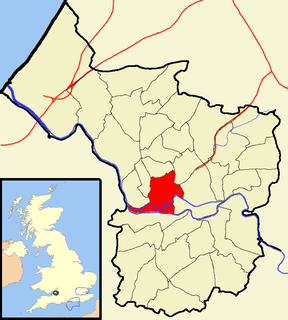
Cabot was a council ward that covered the centre of Bristol, England. It took its name from the Cabot Tower, a memorial tower on Brandon Hill that was built to commemorate John Cabot's voyage and "discovery" of North America. The ward was abolished in 2016.

Castle Park is a public open space in Bristol, England, managed by Bristol City Council. It is bounded by the Floating Harbour and Castle Street to the south, Lower Castle Street to the east, and Broad Weir, Newgate and Wine Street to the north. Its western boundary is less obviously defined and has been the subject of controversy, perhaps because the area around High Street and St Mary le Port Church, though not part of the park and always intended for development, is often considered at the same time as the park.
Redcliffe, also known as Redcliff, is a district of the English port city of Bristol, adjoining the city centre to the northwest. It is bounded by the loop of the Floating Harbour to the west, north and east, together with the New Cut of the River Avon to the south. Most of Redcliffe lies within the city ward of Lawrence Hill, although the westernmost section, including the cliffs and hill from which the area takes its name, is in Cabot ward. Bristol Temple Meads station is located in Redcliffe.

Temple Church, also known as Holy Cross Church, is a ruined church in Redcliffe, Bristol, England. It is on the site of a previous, round church of the Knights Templar, which they built on land granted to them in the second quarter of the 12th century by Robert of Gloucester. In 1313 the Knights Hospitaller acquired the church, following the suppression of the Templars, only to lose it in 1540 at the time of the Dissolution of the Monasteries. By the early 14th century, the church served as the parish church for the area known as Temple Fee. From around the same time, the rebuilding of the church on a rectangular plan started. This was completed by 1460, with the construction of a leaning west tower.

Chester Shot Tower, also known as Boughton Shot Tower, is a grade-II*-listed shot tower located at SJ413667 in the Boughton district of Chester, England. The tower stands beside the Shropshire Union Canal and forms part of the disused Chester Leadworks. Built by Walkers, Parker & Co. in 1799, the tower is the oldest of three remaining shot towers in the UK, and probably the oldest such structure still standing in the world.

Uphill is a village in the civil parish of Weston-super-Mare in North Somerset, England, at the southern edge of the town, on the Bristol Channel coast.

Tower Hill State Park is a state park of Wisconsin, United States, which contains the reconstructed Helena Shot Tower. The original shot tower was completed in 1832 and manufactured lead shot until 1860. It was added to the National Register of Historic Places in 1973. The park abuts the Wisconsin River and is bordered by state-owned land comprising the Lower Wisconsin State Riverway.

One Redcliff Street, Bristol, England, formerly known as the Robinson Building, was built in 1964 as the headquarters of paper and packaging manufacturer E. S. & A. Robinson. Robinsons had occupied the site since 1846. At the time of construction it was the first high rise building in Bristol to "break an unofficial height limit" of 30.5 metres (100 ft). The Robinson building caused "controversy, both locally and nationally, and was seen by many as failing to respond to its environment, in particular its physical relationship to the adjacent Church of St Thomas". However, prominent architect Basil Spence described it as "a gift to the City". It was considered for the Statutory List of Buildings of Special Architectural or Historic Interest in 2007, but the application was refused. Law firm TLT LLP occupies the 7th, 8th and 10th-13th floors of the building and Patent & Trade Mark Specialists Withers & Rogers LLP occupies the 9th and part of the 5th with the rest of the floor being vacant.
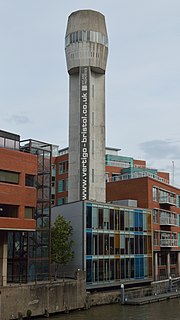
The Cheese Lane Shot Tower is a grade II listed shot tower in the English city of Bristol. It was built in 1969, and was a replacement for an earlier shot tower, the very first such tower ever built. It now forms part of an office development called Vertigo, and is located on the north bank of the Floating Harbour upstream of Castle Park. There is no public access to the interior of the tower.

Redcliffe Caves are a series of man made tunnels beneath the Redcliffe area of Bristol, England.




















